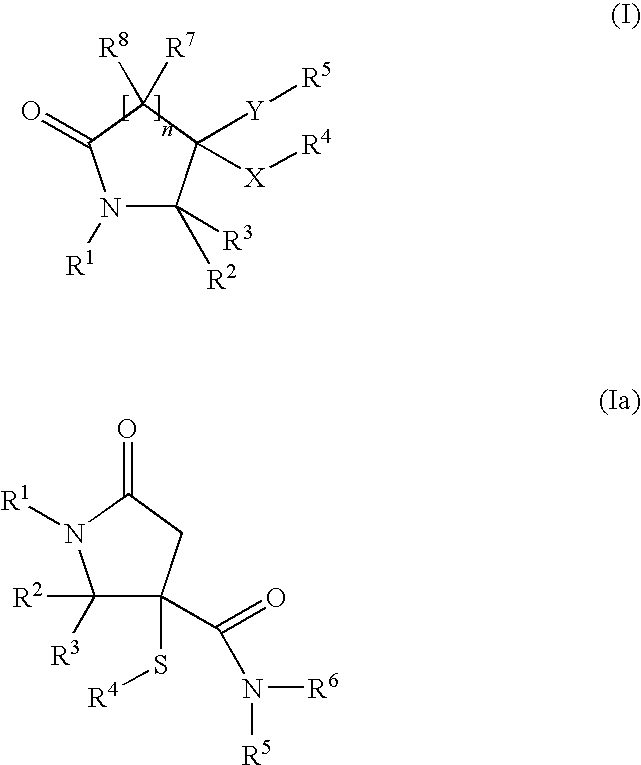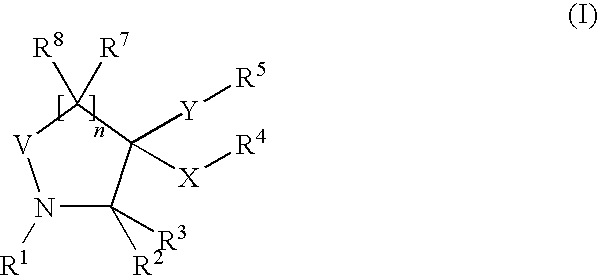Novel pyrrolidin-2-ones
a technology of pyrrolidin and pyrrolidin, which is applied in the field of new pyrrolidin2ones, can solve the problems of misregulation and change in the normal ratio of hdm2 to p53, and achieve the effect of preventing cancer and facilitating cancer treatmen
- Summary
- Abstract
- Description
- Claims
- Application Information
AI Technical Summary
Benefits of technology
Problems solved by technology
Method used
Image
Examples
example 1
General Procedure for the Synthesis of 5-oxo-3-sulfanyl-pyrrolidin-3-carboxamides (I):
Maleic anhydride (IV, 1 mmol), a thiol (V, 1 mmol), aldehyde or ketone (III, 1 mmol) and amine (II, 1 mmol) in toluene (8 mL) were heated to 150° C. in a sealed tube for 24 hours. After cooled to room temperature, the solution was concentrated in vacuo. Purification on silica gel using an eluent (ethyl acetate: methanol=9:1 to 1:1) yielded compounds of formula (VI) as a diastereoisomeric mixture. Afterwards, the two diastereoisomers were separated by preparative HPLC chromatography. Preparative separations were usually performed with an acetonitrile-water eluent (+0.1% formic acid) on a RP Polaris C18 column (length: 250 mm, diameter: 21 mm; particle size: 5 μm). Generally, good separations were observed (retention times of the two cis / trans diasteroisomers differed by 1 to 2 minutes) by using isocratic systems (70% acetonitrile: 30% water).
To a suspension of 1-(3-dimethylaminopropyl)-3-ethylcarbod...
example 2
According to the general procedure in example 1, the following compounds were prepared:
2.1 cis-2-(6-chloro-1-methyl-1H-indol-3-yl)-1-[(4-chlorophenyl)methyl]-3-[(4-methylphenyl)sulfanyl]-5-oxo-N-(pyridin-2-ylmethyl)pyrrolidine-3-carboxamide. Molecular Formula=C34H30Cl2N4O2S. Molecular Weight=629.599. [M+H]+ observed=629.1. Isolated yield 34.08%.
2.2 trans-2-(6-chloro-1-methyl-1H-indol-3-yl)-1-[(4-chlorophenyl)methyl]-3-[(4-methylphenyl)sulfanyl]-5-oxo-N-(pyridin-2-ylmethyl)pyrrolidine-3-carboxamide. Molecular Formula=C34H30Cl2N4O2S. Molecular Weight=629.599. [M+H]+ observed=629.1. Isolated yield 3.78%.
2.3 trans-2-(6-chloro-1-methyl-1H-indol-3-yl)-1-[(4-chlorophenyl)methyl]-3-[(4-methylphenyl)sulfanyl]-5-oxo-N-(thiophen-2-ylmethyl)pyrrolidine-3-carboxamide. Molecular Formula=C33H29Cl2N3O2S2. Molecular Weight=634.638. [M+H]+ observed=656.0. Isolated yield 3.04%.
2.4 cis-2-(6-chloro-1-methyl-1H-indol-3-yl)-1-[(4-chlorophenyl)methyl]-3-[(4-methylphenyl)sulfanyl]-5-oxo-N-(thiophen-2-ylmeth...
example 3
1) Synthesis of 4-[5-oxo-pyrrolidine-3-carbonyl]-piperazine-1-carboxylic Acid Ethylamide Compounds
Synthesis of (cis)-4-[1-(4-Bromo-benzyl)-2-(6-chloro-1H-indol-3-yl)-5-oxo-3-p-tolylsulfanyl-pyrrolidine-3-carbonyl]-piperazine-1-carboxylic acid ethylamide [PXN727-d1]
Multicomponent Reaction (Step 1):
Maleic anhydride 2 (6 mmol), thiol 4 (6 mmol), aldehyde 3 (6 mmol) and amine 1 (6 mmol) in toluene (50 mL) were heated to 150° C. under Dean-Stark conditions for 24 hours. After being cooled to room temperature, the solution was concentrated in vacuo. Purification on silica gel (ethyl acetate: methanol=9:1 to 1:1) yielded 5 as a diastereoisomeric mixture (1.48 g, 46%).
Literature: J. Wei, J. T. Shaw Org. Lett. 2007, 9, 4077.
Separation of the Diastereoisomeric Mixture:
The above described reaction sequence yielded two diastereoisomers d1 and d2 in a 50:50 ratio. They were separated by preparative HPLC chromatography using the following conditions:Column RP Polaris C18 (length: 250 mm, Ø: 21 mm...
PUM
| Property | Measurement | Unit |
|---|---|---|
| 3-dimensional structure | aaaaa | aaaaa |
| crystal structure | aaaaa | aaaaa |
| structures | aaaaa | aaaaa |
Abstract
Description
Claims
Application Information
 Login to View More
Login to View More - R&D
- Intellectual Property
- Life Sciences
- Materials
- Tech Scout
- Unparalleled Data Quality
- Higher Quality Content
- 60% Fewer Hallucinations
Browse by: Latest US Patents, China's latest patents, Technical Efficacy Thesaurus, Application Domain, Technology Topic, Popular Technical Reports.
© 2025 PatSnap. All rights reserved.Legal|Privacy policy|Modern Slavery Act Transparency Statement|Sitemap|About US| Contact US: help@patsnap.com



